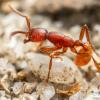- Formiculture.com
- Forums
- Gallery
- Members
- Member Map
- Chat

Can a queenless Tapinoma colony survive with single alate pupa?
Started By
RushmoreAnts
, Jun 10 2020 6:26 AM
5 replies to this topic
#1
 Offline
-
Posted June 10 2020 - 6:26 AM
Offline
-
Posted June 10 2020 - 6:26 AM
So, I recently acquired a Tapinoma sessile colony with several hundred workers. Three queens were introduced, yet apparently they were rejected, as they were not with the colony. The colony now has but a single queen pupa. I am aware these can breed in the nest, yet I was wondering if the workers might lay male eggs? I’m hoping some of their current brood is male, though.
"God made..... all the creatures that move along the ground according to their kinds (including ants). And God saw that it was good. Genesis 1:25 NIV version
Keeping:
Tetramorium immigrans Camponotus vicinus, modoc, novaeboracensis, herculeanus
Formica pallidefulva, argentea Solenopsis molesta
Formica cf. aserva Lasius brevicornis, neoniger
#2
 Offline
-
Posted June 10 2020 - 7:10 AM
Offline
-
Posted June 10 2020 - 7:10 AM
We know that sibling mating has been reported in literature but this has not actually to my knowledge been confirmed. I believe it is one explanation for polygyny being present, but I am not aware of any observations or genetic analysis to confirm sibling mating. It is suspected that gynes attract males from other colonies and then just stay within their natal colony but again this has not been confirmed to my knowledge. Upshot, you may try. I have never had any success in getting this species to mate in a laboratory setting and I am not aware of it being done.
- RushmoreAnts likes this
#3
 Offline
-
Posted June 10 2020 - 9:18 AM
Offline
-
Posted June 10 2020 - 9:18 AM
We know that sibling mating has been reported in literature but this has not actually to my knowledge been confirmed. I believe it is one explanation for polygyny being present, but I am not aware of any observations or genetic analysis to confirm sibling mating. It is suspected that gynes attract males from other colonies and then just stay within their natal colony but again this has not been confirmed to my knowledge. Upshot, you may try. I have never had any success in getting this species to mate in a laboratory setting and I am not aware of it being done.
I've got them to mate in petri dishes.
My Main Journal | My Neivamyrmex Journal | My Ant Adoption | My YouTube
Join the TennesseeAnts Discord Server! https://discord.gg/JbKwPgs
#4
 Offline
-
Posted June 10 2020 - 9:31 AM
Offline
-
Posted June 10 2020 - 9:31 AM
We know that sibling mating has been reported in literature but this has not actually to my knowledge been confirmed. I believe it is one explanation for polygyny being present, but I am not aware of any observations or genetic analysis to confirm sibling mating. It is suspected that gynes attract males from other colonies and then just stay within their natal colony but again this has not been confirmed to my knowledge. Upshot, you may try. I have never had any success in getting this species to mate in a laboratory setting and I am not aware of it being done.
I've got them to mate in petri dishes.
that is good to know, I will continue to try then
Were they siblings?
- TennesseeAnts likes this
#5
 Offline
-
Posted June 10 2020 - 9:34 AM
Offline
-
Posted June 10 2020 - 9:34 AM
We know that sibling mating has been reported in literature but this has not actually to my knowledge been confirmed. I believe it is one explanation for polygyny being present, but I am not aware of any observations or genetic analysis to confirm sibling mating. It is suspected that gynes attract males from other colonies and then just stay within their natal colony but again this has not been confirmed to my knowledge. Upshot, you may try. I have never had any success in getting this species to mate in a laboratory setting and I am not aware of it being done.
I've got them to mate in petri dishes.
that is good to know, I will continue to try then
Were they siblings?
I don't know if they were or not. I grabbed them from a large colony with many queens... I assume they were unrelated.
My Main Journal | My Neivamyrmex Journal | My Ant Adoption | My YouTube
Join the TennesseeAnts Discord Server! https://discord.gg/JbKwPgs
#6
 Offline
-
Posted June 10 2020 - 10:19 AM
Offline
-
Posted June 10 2020 - 10:19 AM
in these situations run an aggression test: have 3 workers from one colony and 3 from the other. Make sure they are calm and introduce them. If there are clear signs of aggression: grabbing with mandibles, twisting gasters to spray formic acid then they are from non-sibling colonies.
- TennesseeAnts likes this
1 user(s) are reading this topic
0 members, 1 guests, 0 anonymous users














